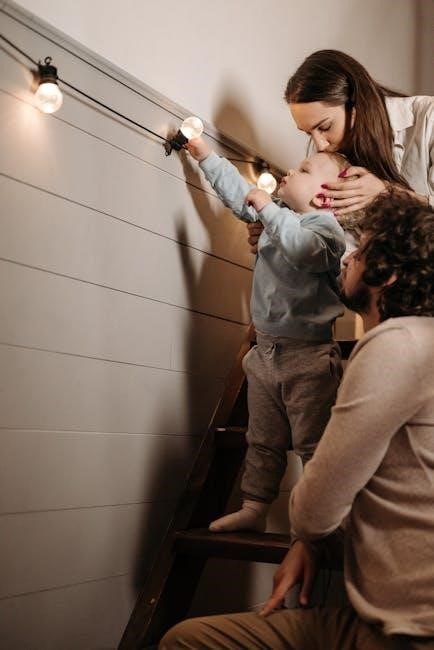Downsizing for aging parents involves transitioning to a simpler lifestyle, addressing emotional attachments, and organizing belongings․ This guide offers practical advice and support for families navigating this process․
1․1 What is Downsizing?
Downsizing is the process of reducing the size of a living space and simplifying possessions, often undertaken by aging parents to transition to a more manageable lifestyle․ It involves decluttering, organizing, and deciding what to keep, donate, or discard․ Downsizing aims to create a simpler, more practical living environment, addressing both physical and emotional needs․ For many, it’s about moving to a smaller home or senior living facility, focusing on essential items and memories․ This process helps reduce maintenance burdens and financial costs, promoting a more relaxed and organized life․ Understanding what downsizing entails is crucial for families to approach it effectively and compassionately․
1․2 Why Downsizing is Important for Aging Parents
Downsizing is crucial for aging parents as it simplifies living arrangements and enhances safety, reducing the risk of accidents in large, cluttered spaces․ It alleviates financial burdens by lowering housing and maintenance costs, allowing resources to be allocated to healthcare and other needs․ Additionally, downsizing promotes mental well-being by removing the stress of managing a large home and focusing on meaningful possessions․ This transition also encourages social engagement and community integration, which are vital for emotional health․ By addressing physical and emotional challenges, downsizing supports aging parents in maintaining independence and improving quality of life during their golden years․ It’s a proactive step toward a more comfortable and secure future․
1․3 Emotional Aspects of Downsizing
Downsizing often triggers strong emotions for aging parents, as it involves letting go of belongings and memories tied to a lifetime of experiences․ Seniors may feel a deep sense of loss, grief, and nostalgia when parting with items that hold sentimental value․ This process can also stir feelings of identity loss, as possessions often reflect personal history and achievements․ Family dynamics may become strained as adult children and parents navigate differing opinions on what to keep or discard․ Emotional resistance is common, as downsizing forces confrontation with aging and mortality․ Understanding and addressing these emotional challenges is essential to making the transition smoother and more compassionate for everyone involved․

Understanding the Downsizing Process
Downsizing involves evaluating the current living situation, planning for future needs, and organizing belongings․ It requires a thoughtful approach to create a manageable and sustainable living environment․
2․1 Evaluating the Current Living Situation
Evaluating the current living situation is the first step in downsizing․ Assess the home’s condition, safety, and maintenance needs․ Consider the emotional value of belongings and identify what truly matters․ Involve aging parents in this process to respect their feelings and decisions․ Start with one room at a time to avoid overwhelm․ Create a checklist to track progress and prioritize items․ This step helps families understand what needs to be kept, donated, or discarded․ Professional organizers can also provide guidance․ Remember, downsizing is not just about reducing space but creating a more manageable and comfortable environment for the future․
2․2 Assessing Future Needs and Preferences
Assessing future needs and preferences is crucial for a successful downsizing process․ Consider aging parents’ lifestyle, mobility, and health requirements․ Discuss their preferences for living arrangements, such as staying in a familiar area or moving closer to family․ Evaluate the need for accessibility features and storage solutions․ Involve parents in decision-making to ensure their comfort and satisfaction․ Reflect on their hobbies and social interactions to tailor the new space․ This step ensures the transition aligns with their values and enhances their quality of life․ Understanding their vision for the future helps create a practical and fulfilling living environment․ Open communication is key to meeting their emotional and practical needs effectively․
2․3 Setting Realistic Goals for Downsizing
Setting realistic goals is essential for a smooth downsizing process․ Start by identifying clear objectives, such as reducing clutter or moving to a smaller home․ Break tasks into manageable steps to avoid overwhelm․ Consider timelines and prioritize what needs immediate attention․ Involve aging parents in goal-setting to ensure their needs and preferences are met․ Be flexible to adapt plans as circumstances change․ Celebrate small achievements to maintain motivation․ Setting achievable milestones fosters a sense of progress and reduces stress․ Realistic goals ensure the downsizing process remains organized and focused, ultimately leading to a successful transition․ This approach helps balance practicality with emotional well-being, making the experience more manageable for everyone involved․
Involving Family Members
Involving family members ensures emotional support and practical help for aging parents․ Open communication and collaboration create a unified approach to downsizing, easing the transition and providing comfort․
3․1 Communicating with Aging Parents
Effective communication with aging parents is crucial for a smooth downsizing process․ Approach conversations with empathy, understanding their emotional attachment to belongings․ Listen actively to their concerns and preferences, ensuring they feel heard and respected․ Avoid imposing decisions; instead, involve them in planning to maintain control․ Patience is key, as they may resist change or feel vulnerable․ Open dialogue helps build trust and cooperation, making the transition less stressful․ Encourage them to share memories and thoughts about possessions, which can aid in decision-making․ Creating a supportive environment fosters mutual understanding and strengthens family bonds during this challenging time․
3․2 Role of Adult Children in Downsizing
Adult children play a vital role in supporting aging parents during downsizing․ They can initiate gentle conversations about the benefits of downsizing, helping parents envision a simpler lifestyle․ Offering emotional support and practical assistance, such as organizing belongings or researching senior living options, eases the transition․ It’s important to respect parents’ autonomy while providing guidance․ Adult children can also facilitate decision-making by creating a structured plan, ensuring the process is manageable․ Their involvement helps minimize overwhelm and fosters a sense of teamwork, making the downsizing journey less daunting for everyone involved․ Balancing respect with support is key to a successful and harmonious experience․
3․3 Building a Supportive Family Team
Building a supportive family team is essential for a smooth downsizing process․ Open communication and shared responsibilities help ease the emotional and physical challenges․ Assign roles based on family members’ strengths, ensuring everyone contributes meaningfully․ Respect parents’ decisions while offering guidance, fostering a collaborative environment․ Encourage unity by celebrating small achievements and acknowledging each person’s efforts․ A united front helps reduce stress and creates a positive experience for all․ Involving siblings, spouses, or other relatives ensures no single person bears the burden alone․ This collective approach not only lightens the workload but also strengthens family bonds during this transition․

Managing Belongings
Managing belongings during downsizing involves sorting, categorizing, and deciding what to keep, donate, or discard․ This process helps create a more organized and clutter-free living space․
4․1 Sorting and Decluttering
Sorting and decluttering are essential steps in managing belongings during downsizing․ Start by categorizing items into groups, such as essentials, sentimental keepsakes, items to donate, and items to discard․ This process can be emotionally challenging, especially when dealing with items that hold memories․ Encourage your parents to let go of items that are no longer useful or necessary․ Consider involving family members to help with the decision-making process, ensuring everyone’s opinions are heard․ Professional organizers can also provide guidance and support to make the task less overwhelming․ Remember, the goal is to create a more organized, clutter-free living environment that promotes comfort and simplicity․
4․2 Deciding What to Keep, Donate, or Discard
Deciding what to keep, donate, or discard is a crucial part of downsizing․ Start by evaluating each item based on its practical use and emotional value․ Encourage your parents to keep only what brings joy or serves a purpose․ Items that are no longer needed but still in good condition can be donated to charities or sold․ Discard items that are broken or have no use․ This process can be emotional, so it’s important to approach it with sensitivity and patience․ Creating a clear plan and involving family members can help make decisions easier and ensure everyone is on the same page․ Remember, downsizing is about simplifying and creating a more manageable living space․
4․3 Organizing and Categorizing Items
Organizing and categorizing items is essential for a smooth downsizing process․ Start by grouping items into categories, such as clothing, books, kitchenware, and sentimental items․ Use clear labels and storage solutions to keep things tidy․ Begin with small areas to avoid feeling overwhelmed․ Sort items into “keep,” “donate,” and “discard” piles, and involve family members to make decisions easier․ Consider the emotional value of items, but also focus on practicality․ A well-organized approach ensures that the new space is functional and clutter-free, making the transition to a smaller home more manageable․ This step helps create a sense of control and clarity during the downsizing journey․

Practical Strategies for Downsizing
Effective downsizing involves tackling one room at a time, using efficient packing tips, and considering professional organizers for a stress-free transition to a smaller space․
5․1 Downsizing Room by Room
Downsizing room by room helps manage the process effectively․ Start with areas of low sentimental value, like the kitchen or garage, to build momentum․ Sort items into categories: keep, donate, sell, or discard․ Use storage bins and labels for clarity․ Focus on essential items and let go of duplicates or unused belongings․ Consider the space needs of the new home to guide decisions․ Pack non-essential items first to simplify moving day․ Tackle sentimental areas, like bedrooms, last to allow time for emotional processing․ Celebrate progress after each room to stay motivated․ This systematic approach ensures a smoother transition and reduces overwhelm for aging parents․
5․2 Tips for Efficient Packing
Efficient packing is key to a smooth downsizing process․ Start by gathering sturdy boxes, packing paper, and labels․ Pack room by room to maintain organization․ Label each box with its contents and the room it belongs in․ Use smaller boxes for heavier items and larger ones for lighter goods․ Fill empty spaces with soft items like linens to prevent shifting․ Pack essentials like toiletries and medications separately for easy access․ Consider color-coding boxes by room to simplify unpacking․ Create a detailed inventory list for tracking․ Pack a “first night” box with essentials for each family member․ Involve your parents in packing decisions to ensure their comfort and reduce stress during the transition․
5․3 Leveraging Professional Organizers
Professional organizers specialize in helping families manage downsizing challenges․ They offer expert strategies for sorting, decluttering, and organizing belongings․ These professionals can create tailored plans to meet your parents’ specific needs, ensuring a smooth transition․ They often handle tasks like packing, labeling, and arranging items efficiently․ Professional organizers can also assist with decision-making, helping your parents decide what to keep, donate, or discard․ Their expertise reduces stress and saves time, allowing families to focus on emotional well-being․ By hiring a professional, you can ensure the downsizing process is systematic and respectful of your parents’ memories and preferences, creating a more comfortable and functional living space․
Financial Considerations
Downsizing involves budgeting for moving costs, understanding senior living expenses, and managing the financial benefits of selling or donating items, ensuring a stable financial future for aging parents․
6․1 Budgeting for Downsizing
Budgeting for downsizing requires careful planning to cover costs such as hiring professional organizers, packing materials, and moving services․ It’s essential to assess the total expenses and create a realistic financial plan․ Families should also consider potential savings from selling items or reducing household expenses․ Allocating funds for unexpected costs, like repairs or storage, is wise․ A well-structured budget ensures the downsizing process remains manageable and stress-free․ Open communication about financial priorities helps everyone involved stay aligned and focused on achieving the goal of a simpler, more affordable living situation for aging parents․
6․2 Understanding the Cost of Senior Living
Understanding the cost of senior living is crucial for families planning a parent’s downsizing․ Expenses vary widely depending on the type of housing, location, and level of care needed․ Options include independent living communities, assisted living facilities, and memory care units, each with different price points․ Monthly fees often cover housing, meals, and some services, while additional costs may apply for medical care or amenities․ Researching and comparing facilities helps families make informed decisions․ It’s important to consider long-term financial implications and explore payment options, such as using proceeds from home sales or applying for financial assistance programs․ Transparent budgeting ensures a sustainable and comfortable living arrangement for seniors․
6․3 Selling or Donating Items
Selling or donating items is a key part of the downsizing process for aging parents․ It helps reduce clutter, generates income for moving costs, and can provide tax benefits․ Families should evaluate which items hold sentimental value and which can be let go of․ Online marketplaces, estate sales, and local charities are popular options for selling or donating․ Involving family members in decision-making can ease emotional challenges․ Professional organizers can also assist in appraising and managing items․ This step not only simplifies the living space but also creates a sense of relief and fulfillment for both parents and their families․

Emotional and Psychological Challenges
Downsizing can trigger grief, loss, and identity struggles for aging parents․ Emotions often stem from sentimental attachments to belongings and memories․ Creating a supportive system is crucial․
7․1 Coping with Sentimental Attachments
Aging parents often struggle with sentimental attachments to belongings, as these items hold memories and emotional value․ Acknowledging these feelings is crucial to ease the downsizing process․ Creating a memory box or digital archive for cherished items can help preserve memories without clutter․ Families should encourage open conversations to understand the emotional significance of certain objects․ Involving parents in decision-making ensures their voices are heard and respected․ Professional organizers can also provide guidance on handling sentimental items compassionately․ Balancing practical needs with emotional ties fosters a supportive environment for everyone involved․
7․2 Addressing Grief and Loss
Downsizing often triggers grief and loss, especially when aging parents must part with cherished possessions, a family home, or a familiar lifestyle․ These emotions are natural and valid, as belongings and spaces hold memories and identity․ Acknowledging these feelings is essential for a healthy transition․ Families can help by creating opportunities to reflect on memories, such as sharing stories or preserving meaningful items․ Professional organizers and counselors can also provide guidance to navigate these emotional challenges․ Allowing parents time to process their emotions while offering reassurance and support can make the downsizing process less overwhelming and more compassionate․
7․3 Creating a Support System
Building a strong support system is crucial for aging parents during downsizing, helping them cope with emotional and practical challenges․ Family members should communicate openly, offering reassurance and understanding․ Involving adult children in decision-making fosters collaboration and reduces feelings of isolation․ Professional organizers and senior relocation specialists can also provide expert guidance, easing the process․ Additionally, connecting with peers who have gone through similar experiences can offer emotional support and practical advice․ A supportive environment ensures that parents feel valued and empowered throughout their downsizing journey, making the transition smoother and less stressful for everyone involved․
Transitioning to a New Home
Transitioning to a new home involves selecting the right senior living option, designing a functional space, and adjusting to smaller quarters, ensuring a smooth and positive experience․
8․1 Choosing the Right Senior Living Option
Selecting the appropriate senior living option is crucial for a successful transition․ Consider factors such as location, amenities, and levels of care․ Understanding your parent’s needs and preferences ensures a smooth move․ Researching communities, reading reviews, and visiting facilities can help make an informed decision․ It’s important to involve your parents in the process to ensure their comfort and satisfaction․ A supportive environment that aligns with their lifestyle and healthcare requirements is essential for their well-being․ This step lays the foundation for a positive and fulfilling new chapter in their life․
8․2 Designing the New Space
Designing the new space involves creating a functional and comforting environment tailored to your parent’s needs․ Start by assessing the layout and prioritizing essential items․ Involve your parents in decisions to ensure the space reflects their preferences and lifestyle․ Consider multi-functional furniture and storage solutions to maximize efficiency․ Incorporate personal touches, such as family photos or cherished items, to make the space feel familiar and inviting․ Organizing belongings in a logical and accessible manner is key to fostering independence․ Technology, like smart home devices, can also enhance safety and convenience․ The goal is to craft a space that balances practicality with personal style, ensuring a smooth transition and a sense of home․
8․3 Adapting to Smaller Living Quarters
Adapting to smaller living quarters can be challenging but manageable with the right mindset․ Start by focusing on essential items and prioritizing functionality over quantity․ Encourage your parents to embrace minimalism, emphasizing the benefits of reduced maintenance and clutter-free living․ Emotional attachment to belongings can complicate the process, so involve them in decisions about what to keep or let go of․ Maintain a sense of control by allowing them to personalize their new space with cherished items․ Practical strategies, such as optimizing storage and using multi-functional furniture, can enhance comfort and efficiency․ Patience and support are crucial as they navigate this significant life change․
Celebrating the Downsizing Journey
Celebrating the downsizing journey involves acknowledging progress, creating new memories, and embracing a simpler lifestyle․ Recognize achievements and cherish the positive outcomes of this meaningful transition․
9․1 Acknowledging Achievements
Acknowledging achievements in downsizing is crucial for morale․ Recognize the effort put into decluttering, organizing, and transitioning․ Celebrate milestones, no matter how small, to honor progress and resilience․ This validation helps create a positive experience, reinforcing the benefits of downsizing․ By praising accomplishments, families can foster a sense of pride and fulfillment․ It’s important to highlight how these achievements contribute to a more manageable and enjoyable living situation․ Acknowledgment also strengthens family bonds and encourages continued cooperation throughout the process․ Remember, every step forward is a success worth celebrating․
9․2 Creating New Memories
Creating new memories during downsizing helps shift focus from loss to renewal․ Personalize the new space with cherished items, fostering a sense of home․ Engage in activities like family dinners or storytelling to build new traditions․ This process encourages emotional healing and strengthens family bonds․ Celebrate the transition by creating a memory book or scrapbook with photos of meaningful items․ Downsizing isn’t just about letting go—it’s about embracing new experiences and making lasting memories in a smaller, more manageable environment․ These moments create a sense of continuity and hope for the future, making the downsizing journey more meaningful and fulfilling․
9․3 Embracing a Simpler Lifestyle
Embracing a simpler lifestyle is a transformative aspect of downsizing․ It encourages a shift from material accumulation to valuing experiences and relationships․ A smaller living space fosters organization and reduces clutter, creating a more peaceful environment․ This transition allows aging parents to focus on what truly matters, such as family, hobbies, and personal growth․ Simplifying life can also reduce stress and financial burdens, promoting a sense of freedom and renewal․ By letting go of unnecessary possessions, individuals can rediscover joy in simplicity and build a more fulfilling life․ Downsizing becomes an opportunity to redefine priorities and embrace a more meaningful, clutter-free existence․
Downsizing is a journey of simplicity, emotional resilience, and renewal․ It empowers aging parents to focus on what truly matters, fostering peace and clarity․
10․1 Recap of Key Points
Downsizing for aging parents is a complex yet rewarding process that involves emotional, practical, and financial considerations․ It requires open communication, family support, and a focus on simplifying life․ Key steps include evaluating current living situations, setting realistic goals, and addressing sentimental attachments․ Organizing belongings through sorting, categorizing, and deciding what to keep, donate, or discard is essential․ Leveraging professional organizers and creating a supportive team can ease the transition․ Financial planning, including budgeting and understanding senior living costs, is crucial․ Ultimately, downsizing empowers parents to embrace a simpler lifestyle, adapt to new environments, and create lasting memories, fostering peace and clarity for the future․
10․2 Encouragement for the Future
Embrace the future with confidence and positivity as your parents navigate their new lifestyle․ Downsizing is a courageous step toward simplicity and comfort, allowing them to focus on what truly matters․ Encourage them to view this transition as an opportunity for new experiences and meaningful connections․ Celebrate their strength and resilience as they adapt to their new environment․ Remind them that it’s okay to seek support and that their well-being is a priority․ By fostering a positive mindset, they can thrive in their new space, creating joyful memories and embracing a future filled with peace and clarity․ Stay supportive and optimistic, knowing this journey leads to a more manageable and fulfilling life․
10․3 Final Words of Wisdom
As you and your parents conclude this downsizing journey, remember that patience and compassion are key․ Acknowledge the emotional and physical efforts invested in this process․ Encourage your parents to cherish memories while embracing their new, simpler lifestyle․ Focus on creating a safe, comfortable, and organized living space that reflects their personality․ Foster open communication and involve them in decision-making to ensure their needs and preferences are met․ Professional organizers and family support can greatly ease the transition․ Celebrate their achievements and the new beginnings ahead․ Downsizing is not just about reducing belongings but about enhancing quality of life, ensuring peace of mind for both parents and their loved ones․